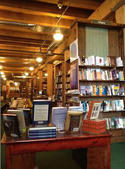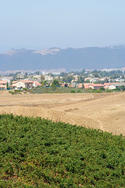One of the most frequently recurring justifications for densification policies (smart growth, growth management, livability, etc.) lies with the assumption that the automobile-based mobility system (Note 1) disadvantages lower income citizens. Much of the solution, according to advocates of densification is to discourage driving and orient both urbanization and the urban transportation system toward transit as well as walking and cycling. read more »
Urban Issues
New Urbanism vs. Dispersionism
The Florida real estate developer, unburdened of state regulatory agencies, may now focus his efforts on pleasing the investment community and the local market. I recently played the role of real estate developer interviewing two consultant teams vying to help me create a new fictional community. Fortified with readings in both the New Urbanist camp and the Dispersionist camp, each team of students pitched their method of community building to me. read more »
Indianapolis: From Naptown to Super City
I have long touted the sports strategy that Indianapolis used to revitalize its downtown as a model for cities to follow in terms of strategy led economic and community development. I really think it sets the benchmark in terms of how to do it, and it has been very successful.
Indy is hosting the Super Bowl on Sunday, something that is locally seen as a sort of crowning achievement of the 40 year sports journey. As part of that, the Indianapolis Star and public TV station WFYI produced an hour long documentary on the journey called “Naptown to Super City.” I think it’s a must watch for anyone who is trying to figure out to revitalize their own downtown. read more »
The Evolving Urban Form: Guangzhou-Foshan
The Pearl River Delta of China is home to the largest extent of continuous urbanization in the world. The Pearl River Delta has 55 million people in the jurisdictions of Hong Kong, Shenzhen, Dongguan, Guangzhou, Foshan, Zhongshan, Jiangmen, Zhuhai and Macau. Moreover, the urban population is confined to barely 10 percent of the land area. These urban areas are the largest export engine of China and reflect the successful legacy of Deng Xiaoping's reforms which had their start with the special economic zone in Shenzhen and spread to the rest of the Delta and then much of the nation.
Adjacent Metropolitan Areas: However, the Pearl River Delta today is not a metropolitan area, as is often asserted. Instead it is rather a collection of adjacent metropolitan areas or labor markets (Figure 1). Metropolitan areas are not created by a large number of people living close to one another. Metropolitan areas are labor markets, crudely delineating the geography of the jobs-housing balance. read more »
How Libraries and Bookstores Became the New Community Centers
Bookstores and libraries have long played a central role in fostering a deeper appreciation of knowledge, and in lifelong learning. Increasingly, these places are also filling another critical need in our communities, by providing a haven for those seeking a communal connection in an ever-more isolated world.
Ray Oldenburg, author of The Great Good Place, coined the term “third place” to describe any environment outside of the home and the workplace (first and second places, respectively) where people gather for deeper interpersonal connection. Third places include, for example, places of worship, community centers, and even diners or pubs frequented by the “locals.” read more »
America’s Demographic Future
Perhaps nothing has more defined America and its promise than immigration. In the future, immigration and the consequent development of what Walt Whitman (1855: iv) called “a race of races” will remain one of the country’s greatest assets in the decades to come. read more »
Britain Fears a Developer’s Charter
The UK Government’s Department for Communities and Local Government (DCLG) announced that there were only 127,780 new housing completions last year in Britain. British house building activity is down to levels of after the First World War, when reliable industrial records began, and still falling. In 1921 the British population was nearly back up to 43 million following the slaughter of the First World War. In 2011 the population of England, Wales, and Scotland is approaching 61 million people. By 2031 the British population is expected to be closer to 70 million. read more »
Preserving the "Ideal of a Property Owning Democracy:" Annual Demographia International Housing Affordability Survey
Demographia and Performanceurbanplanning.org have just released the 8th Annual Demographia International Housing Affordability Survey, with an introduction by Professor Robert Bruegmann of the University of Illinois at Chicago and author of Sprawl: A Compact History. read more »
Florida’s Quick Rebound
Adding nearly 119,000 people in 2011, Florida has capped a decade of steady population increase to see the state grow 19% since 2000. Despite 2009, an historic year where more people left than arrived, the overall net growth of Florida has yielded two additional congressional seats, moving the state well on its way towards the becoming third most populous state in the nation. This ascendancy brings new responsibility to the shoulders of the state’s leaders, and the direction this st read more »
Three Cheers for Urban Sprawl
“Hands off Our Land!” screams the Daily Telegraph, like some shotgun-toting red-faced farmer. The newspaper, on behalf of the reactionary toffs who form the least pleasant section of its readership, has launched a campaign directed against ‘urban sprawl’ (ie. the rest of us).
On a good day, the Telegraph serves up enlightened articles by progressive liberals like Janet Daley and Simon Heffer and Jeff Randal (I’m talking about real liberals here, not American Trotskyites). But then it disappears under the desk, drinks some devilish, bubbling potion and emerges looking like Mr Hyde, all wonky teeth and messy hair. “Hands off Our Land” is the Telegraph at its worst - a campaign to thwart the government’s all-too-modest suggestions to reform Britain’s vicious planning laws. read more »






















